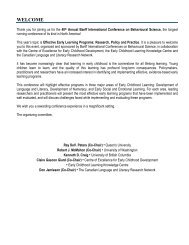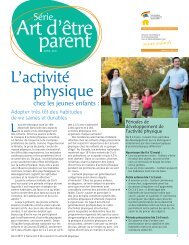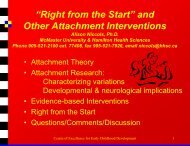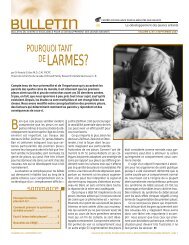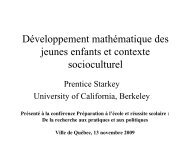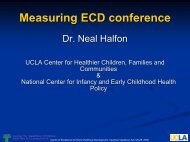Bulletin - The measure of excellence : Canadian early childhood ...
Bulletin - The measure of excellence : Canadian early childhood ...
Bulletin - The measure of excellence : Canadian early childhood ...
You also want an ePaper? Increase the reach of your titles
YUMPU automatically turns print PDFs into web optimized ePapers that Google loves.
SPECIAL FEATURE ON RESEARCH: BIRTHDOES LOW BIRTHWEIGHT INCREASETHE RISK OF DEVELOPING CORONARY HEART DISEASE?A fetus with restricted growth willweigh less at birth and may potentiallyface a daunting array <strong>of</strong>health and developmentalproblems. In the past decades,researchers thought that low birthweightincreased the risk <strong>of</strong>developing coronary heart diseaselater in life. However, as a team <strong>of</strong>Swedish and <strong>Canadian</strong> researchersnoted in an article published in <strong>The</strong>Lancet, these results may have beeninfluenced by factors such asgenetics and <strong>early</strong> environment.Using data drawn from the SwedishTwin Registry, which includes informationon twins born in Swedenbetween 1886 and 1958, the researchteam undertook a case-control studyto investigate the association betweenbirth characteristics (birth weight,birth length and head circumference)and acute myocardial infarction (AMI).<strong>The</strong> researchers selected 132 samesexedco-twin pairs in which one twinhad suffered from AMI while the otherhad not. AMI subjects were also comparedwith 118 individually matchedexternal twins (the researchers wereunable to match external twins for all132 AMI subjects).When twin subjects were comparedwith unrelated control twins,lowbirthweight, birth length and head circumferencewere associated with anincrease in AMI,a result consistent withprevious studies. However, when thesesubjects were compared with theirhealthy co-twins on the above-mentionedbirth characteristics, nodifferences were found. <strong>The</strong> study'sresearchers concluded that, althoughthere is an association between lowbirthweight and AMI, "our findings donot support a direct effect betweenfetal growth and AMI. <strong>The</strong> result suggeststhat genetic, maternal and environmentalfactors during <strong>childhood</strong>and adolescence associated with fetalgrowth may have influenced thepreviously reported associationsbetween birthweight and AMI."John LeBlanc, Assistant Pr<strong>of</strong>essor <strong>of</strong>Pediatrics, Psychiatry, CommunityHealth and Epidemiology at DalhousieUniversity called the study, "very wellconstructed" and praised the two-partstructure whereby researchers usedboth related twins and co-twins ascontrols. "<strong>The</strong> main finding is in thestudy's second part, where twins withAMI were compared with their healthytwin partners. If there is a risk factor forAMI in the <strong>early</strong> uterine environment,itis something that appears to be independent<strong>of</strong> restricted birthweight andmust somehow affect one twin only."LeBlanc added that understanding therole <strong>of</strong> intrauterine growth in terms <strong>of</strong> aperson's overall lifetime health has animpact on health programs and policies."This kind <strong>of</strong> research helps sortout where to put our priorities in terms<strong>of</strong> prevention programs," he said.More research in this area is critical,added Robin Walker, Pr<strong>of</strong>essor <strong>of</strong>Pediatrics at the University <strong>of</strong> Ottawaand Chief <strong>of</strong> Neonatology at theChildren's Hospital <strong>of</strong> Eastern Ontario."This is a very preliminary finding. Youneed more studies and you need largersample numbers," he said.However, doing this research is essential,Walkernoted: "Fetal health, geneticsas well as the child and adolescentenvironment may all be pr<strong>of</strong>oundlyaffecting adult health. We need toknow more about these factors."Ref.:A.Hübinette,S.Cnattingius,A.Ekbom, P. Lichtenstein, U. de Faire andM. S. Kramer. "Birthweight, EarlyEnvironment, and Genetics: A Study<strong>of</strong> Twins Discordant for AcuteMyocardial Infarction." <strong>The</strong> Lancet.Vol. 357. June 2001.VOLUME 1, N O 3 - DECEMBER 2002 BULLETIN OF THE CENTRE OF EXCELLENCE FOR EARLY CHILDHOOD DEVELOPMENT - PAGE 5



